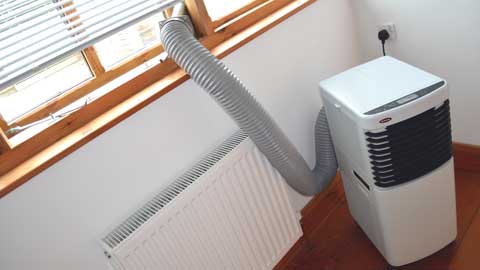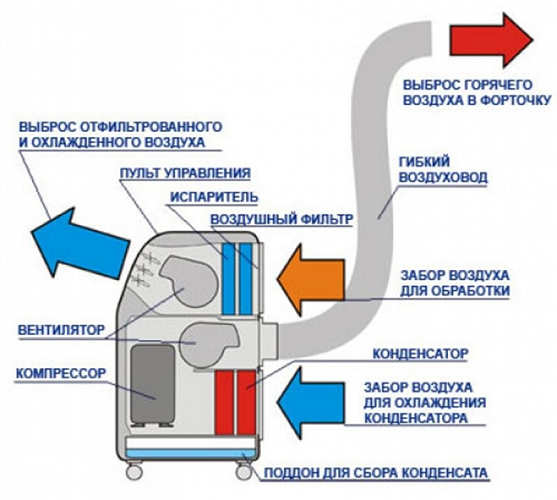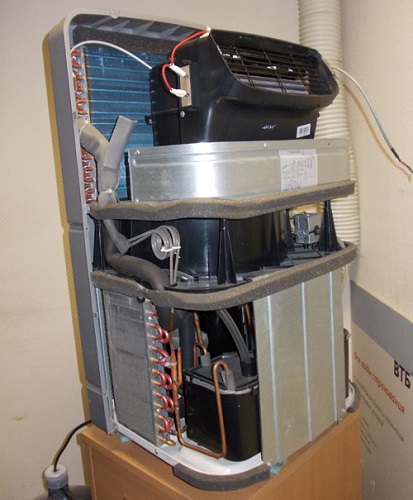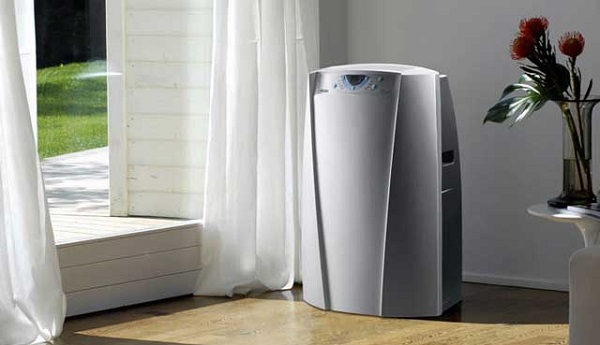How does the floor air conditioner
Such products allow you to cool rooms where standard air conditioners cannot be installed: for example, there are stretch ceilings or walls upholstered in fabric in a rented apartment or in buildings protected by law. The air conditioner possesses not only enviable maneuverability and the lack of installation work on its installation, its cost is half the price of stationary models. If you are going to spend holidays on your car, then you can take the mobile version with you and not pay extra at the resort for air conditioning, having your own. In this article we will examine its design and describe how a mobile air conditioner works.

Content
Operating principle
Each monoblock consists of the following main parts: evaporator and condenser. Structurally, it looks like this: radiators have a single body, and freon circulates inside continuously. The evaporator turns the refrigerant into a gas that absorbs heat from the air, and in the condenser everything happens the other way around.
By design, floor and mobile air conditioners are one and the same all-in-one piece for cooling rooms. The principle of operation of the floor air conditioner is based on processing the air in the room and cooling it to the required temperature. Centrifugal fans suck the air mass into the product through a system of slotted holes: at the top for subsequent cooling, passing the refrigerant circuit through the evaporator, and at the bottom it takes in already cooled air to cool the condenser.
During operation, one of the fans removes the heated air mass through the duct to the street, while the other blows cooled air into the room. Below the body of the product is fluid collection panwhich goes there from the condenser by gravity. Pour it has to the user manually.
You have learned how a floor air conditioner works,Now let's get acquainted with its advantages and disadvantages.

Pros and cons of design
The advantages of mobile devices are obvious:
- relative mobility - just put the product in the room, connect to the network and plant coolness will not work, because some preparatory work will have to be done, but not such a volume as when installing the wall option;
- no complicated installation work, sometimes it is enough to put a duct with a special nozzle in an ajar window;
- no communications for the circulation of freon and condensate;
- no need to coordinate the installation of the unit in different instances.
There is a no less representative list of flaws.
- The entire mechanical part of the air conditioner is located indoors: a compressor that compresses the refrigerant and takes away heat from it. When working, this unit creates a small, but still noise exposure on others. Operating mechanics emit heat, i.e., the product creates a thermal effect, and the principle of operation of a mobile air conditioner is precisely built to combat this phenomenon.
- These products have no condensate discharge, it is collected in a special pan, but you will have to remove it yourself.
- The monoblock is supplied with a corrugated hose for exhaust air to the outside, which also heats up, despite the insulation, and creates additional Greenhouse effect behind the air conditioner.
- For cooling, air is drawn in from the room where it is installed. It turns out that it is used repeatedly, which does not add quality to it.
- Outdoor air conditioning takes, albeit small, but still the space in the room - this is very critical for small rooms.
All these statements are true, but do not be upset - all household appliances have their own advantages and disadvantages, all-in-one computers are no exception to the rule.

The main characteristics of mobile devices
When buying a mobile version of the floor air conditioner, you need to know in advance the exact area and volume of all rooms where it will be used to select the optimum power of the product. Below is a list of key features.
- Power air conditioner is calculated simply - to cool 10 square meters. m. space is enough 1 kW, but it is necessary to take into account the volume of the room, because in different houses there is a significant difference in the height of the ceilings.In the operating instructions, manufacturers prescribe the limiting capabilities of the product, you just have to compare them with the volume of your premises.
- Power consumption - This section is of interest to users in the first place, because here there is a direct connection between the efficiency of the product and the load from its activity on the home power grid. Technical standards assure us that the power consumption of energy of these products is 3 times less than their costs for cooling. The statistics of the operation of this household appliance shows that some modern models can significantly save electrical energy.
- Application inverter motor allows you to significantly reduce the load on the home electrical network, because the temperature will drop gradually, which has a positive effect on the service life of the product.
- Additional heating mode premises allows the use of household appliances of this class during any season, and not just in the summer heat.
There are models with the function of removing dust from the room, eliminating odors due to ionization, and dehumidifying excessively humid air due to ventilation.Some candy bars have the function of adjusting the rotation of the fan, the timer automatically turn on and off the device. Such functions are very convenient when you come back from work and immediately get into a cool room.
Experts advise to choose monoblocks with two hoses - they are more productive and take the air from the street to cool. You can rearrange them by making a universal insert for all windows in advance, for example, from a block with an insect screen, installing plexiglas and the necessary structures for connecting corrugations.
Without air exhaust
Today, there are appeals on many Internet sites to purchase floor air conditioners without an air duct, because they are more profitable than other models and do not need additional equipment. But as a “working body”, according to the instruction manual, they water is used.

The principle of operation is simple: through the filter, which is abundantly moistened with water, the warm air from the room is driven through the fan, the water evaporates from the temperature and cools it.
Such tricks were known in the Middle Ages, when camel drivers drove the end of turbans into a flask when crossing deserts - as a result, water soaked the headdress and, evaporating, cooled the head.But there her vapor escaped into the atmosphere, and here they will again enter the room air, moisturizing it. It turns out a vicious circle, and the whole space of the room will not cool down - only a small area near the household appliance itself. Water evaporates, which means that it must be constantly refilled, and manufacturers are advised to take it only chilled, from the refrigerator, which itself adds heat during operation.
Merits air conditioners without duct:
- compactness;
- slow evaporation eliminates the risk of getting a cold;
- no need to use freon;
- all control of the product is on the case, there are models with remote control;
- selection of models with additional options;
- installation and connection of the discharge hoses is not required;
- minimum energy consumption;
- noise exposure depends on fan power.
Despite significant shortcomings, the mobile air conditioner of this design will find its buyers, but they will have to weigh the pros and cons very carefully before acquiring this know-how.

/rating_off.png)











